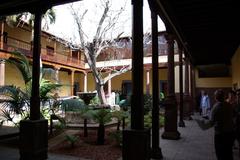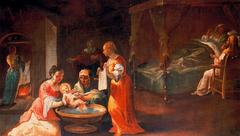La Barranquera Archaeological Zone: Visiting Hours, Tickets, and San Cristóbal de La Laguna Historical Sites Guide
Date: 14/06/2025
Introduction
Perched dramatically on the coastal cliffs of Valle de Guerra in San Cristóbal de La Laguna, Tenerife, the La Barranquera Archaeological Zone stands as a remarkable testament to the island’s indigenous Guanche heritage. This open-access site, protected as a Bien de Interés Cultural (BIC) since 2004, offers visitors the chance to explore the tangible remains of the Guanche civilization—Tenerife’s original Berber-descended inhabitants—and to witness their adaptation to the environment through habitation caves, burial sites, and ritual spaces. With its integration into the broader historical landscape of San Cristóbal de La Laguna—a city whose historic center is a UNESCO World Heritage Site—La Barranquera is both a cultural landmark and a living symbol of heritage preservation.
Whether you’re a history enthusiast, cultural traveler, or researcher, this comprehensive guide provides detailed, up-to-date information on La Barranquera’s visiting hours, ticketing, access, conservation guidelines, and nearby attractions. Enhance your exploration of Tenerife’s ancient roots with practical tips and digital resources such as maps and virtual tours (San Cristóbal de La Laguna Heritage Portal, Tenerife Weekly, Waterpark Tenerife).
Table of Contents
- Introduction
- Guanche Origins and Settlement
- Social Organization and Daily Life
- Religion and Funerary Practices
- Archaeological Features of La Barranquera
- Artistic and Astronomical Heritage
- The Spanish Conquest and Cultural Change
- Visitor Information
- Visitor Experience and Conservation Guidelines
- Frequently Asked Questions (FAQ)
- Visual and Interactive Resources
- Conclusion and Call to Action
- References
Guanche Origins and Settlement
The Guanche people, Tenerife’s original inhabitants, arrived from North Africa around 1000 BCE, bringing Berber roots and forging a unique insular civilization. Isolated for centuries, the Guanches developed distinct social, agricultural, and religious practices. Valle de Guerra, including the La Barranquera zone, provided fertile land and natural shelters ideal for settlement (Cafelam). Archaeological remains throughout La Barranquera illustrate the Guanches’ adaptation to the island’s environment, including their use of caves for both habitation and burial (Waterpark Tenerife).
Social Organization and Daily Life
Guanche society was structured into several “menceyatos” (small kingdoms) led by “menceyes” (kings). Daily life centered on agriculture—mainly barley cultivation—and livestock herding. Habitations, often caves or rock shelters, provided protection and insulation, as evidenced in the archaeological zones of La Barranquera (Waterpark Tenerife). Social stratification was evident, with clear distinctions between nobles, warriors, and commoners (Cafelam).
Religion and Funerary Practices
Religion permeated Guanche life. Polytheistic beliefs centered on deities such as Achamán (sky god), Chaxiraxi (mother goddess), and Magec (sun god). Elaborate funerary rituals, including mummification and placement of grave goods, were practiced to honor the dead (Waterpark Tenerife). La Barranquera’s burial caves, with mummified remains and ritual artifacts, offer direct evidence of these spiritual traditions (Cafelam).
Archaeological Features of La Barranquera
Sepulchral Caves and Burial Customs
The sepulchral caves carved into the cliffs of Barranco del Horno are the site’s most notable features. These caves held mummified remains, shell middens, and ceramics, illuminating Guanche mortuary practices and the importance of the afterlife (Tenerife Weekly).
Habitation Caves and Surface Structures
The El Calabazo complex south of the main site comprises several habitation caves and two burial caves. The largest, partially enclosed by a stone wall, suggests communal living and possible defensive measures. Surface structures near Playa del Roquillo reveal continued use of the coastal environment for daily life (patrimoniomundial.aytolalaguna.es).
Coastal Resource Use
Remains at Playa del Roquillo, including evidence of ancient huts and marine exploitation, highlight the Guanches’ adaptation to coastal resources. Mollusk shells and hand-made ceramics found at the site provide insight into their diet and material culture.
Artistic and Astronomical Heritage
La Barranquera contains engravings and petroglyphs, some with probable ritual or calendrical significance, reflecting the Guanches’ knowledge of astronomy (Tenerife Weekly). Lithophones and symbolic markings suggest music and ritual activities played important roles.
The Spanish Conquest and Cultural Change
The late 15th-century Castilian conquest transformed Guanche society through violence, assimilation, and colonization. Many traditions faded, but Guanche heritage persists in place names, customs, and genetics. La Barranquera stands as a testament to both indigenous resilience and the complex history of cultural change (Waterpark Tenerife).
Visitor Information
Visiting Hours and Ticketing
- Hours: Open daily from 9:00 AM to 6:00 PM (check for local updates or seasonal changes).
- Tickets: Entry is free; donations to support conservation are welcome.
- Management: The site is open-access, with minimal facilities to protect its integrity.
Directions and Accessibility
- Location: Coastal cliffs of Valle de Guerra, San Cristóbal de La Laguna, Tenerife.
- By Car: Take the TF-5 highway toward Valle de Guerra; follow signs to La Barranquera. Informal parking is available.
- By Public Transport: Limited options; take a bus to San Cristóbal de La Laguna and use taxis or hike to the site (Que Hacer en Tenerife).
- Accessibility: The terrain is rugged and includes uneven paths and rocky areas. The site is not accessible for those with limited mobility.
Guided Tours and Educational Programs
Guided tours are occasionally organized by the local cultural department or educational institutions. Booking in advance is recommended for group visits or during peak seasons. Educational workshops and special events are sometimes held in conjunction with cultural festivals (patrimoniomundial.aytolalaguna.es).
Nearby Attractions
- San Cristóbal de La Laguna Old Town: UNESCO World Heritage site with colonial architecture and museums (San Cristóbal de La Laguna UNESCO).
- Museum of Nature and Archaeology (MUNA): Exhibits on Guanche culture (Go Tenerife).
- Playa del Roquillo: Natural rock pools and scenic coastal walks.
- Jover Hamlet: Picturesque fishing village with traditional Canarian charm.
Visitor Experience and Conservation Guidelines
Atmosphere and Amenities
La Barranquera offers a tranquil setting far from mass tourism. The site is surrounded by native flora, dramatic sea views, and a peaceful hamlet. Amenities are minimal; the seasonal Kiosko de La Barranquera offers local seafood.
Conservation Guidelines
- Stay on marked paths; avoid entering caves.
- Do not remove artifacts or disturb archaeological features.
- Carry out all litter and avoid fires.
- Respect local wildlife and plant life.
- Support local conservation efforts and businesses.
Legal protection as a BIC Archaeological Zone is in place, but visitor cooperation is crucial to preserving the site (Planeta Tenerife).
Frequently Asked Questions (FAQ)
Q: What are La Barranquera’s visiting hours?
A: Daily from 9:00 AM to 6:00 PM; open-access with no formal entrance.
Q: Is there an entrance fee?
A: No; admission is free, though donations for conservation are appreciated.
Q: Are guided tours available?
A: Occasionally, through the local cultural department; booking ahead is advised.
Q: How do I get there?
A: Best accessed by car; limited public transport to Valle de Guerra, then taxi or hike.
Q: Is the site accessible for visitors with disabilities?
A: The rugged terrain makes access difficult for those with mobility issues.
Q: Can I take photographs?
A: Yes, but avoid flash inside caves and respect restricted areas.
Q: Are pets allowed?
A: No, to protect archaeological resources and local wildlife.
Visual and Interactive Resources
- High-quality images and maps are available on the San Cristóbal de La Laguna Heritage Portal.
- Virtual tours and detailed photographs enhance pre-visit planning.
- Suggested alt texts:
- “La Barranquera archaeological site on Tenerife’s coastal cliffs”
- “Sepulchral cave at La Barranquera with visible human osteological finds”
- “Trail to El Calabazo caves, Tenerife”
Conclusion and Call to Action
La Barranquera Archaeological Zone is a compelling destination for those seeking to connect with Tenerife’s pre-Hispanic past in a breathtaking coastal setting. By visiting responsibly—respecting conservation guidelines, supporting local initiatives, and utilizing digital resources—you help preserve this irreplaceable heritage for future generations. Expand your journey with visits to San Cristóbal de La Laguna’s old town, the Museum of Nature and Archaeology, and nearby hamlets for a richer understanding of Tenerife’s layered history.
For the latest updates, guided tour schedules, and digital resources, consult the San Cristóbal de La Laguna tourism page, download the Audiala app, and follow relevant social media channels.
References
- San Cristóbal de La Laguna Heritage Portal
- Tenerife Weekly
- Waterpark Tenerife
- Cafelam
- San Cristóbal de La Laguna Tourism
- World Heritage Site: San Cristóbal de La Laguna
- Que Hacer en Tenerife
- Planeta Tenerife
- Planeta Canario
- Go Tenerife - MUNA

